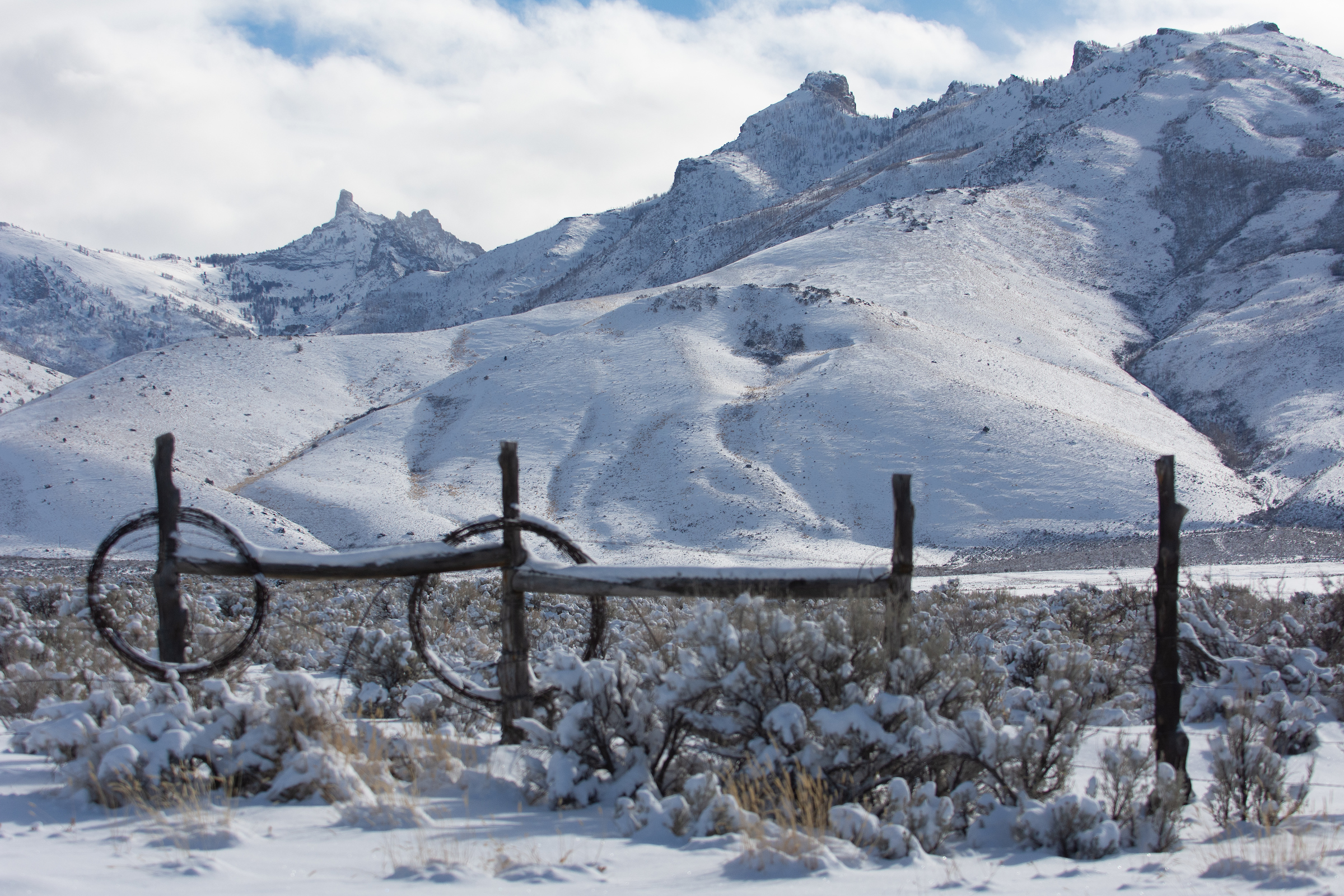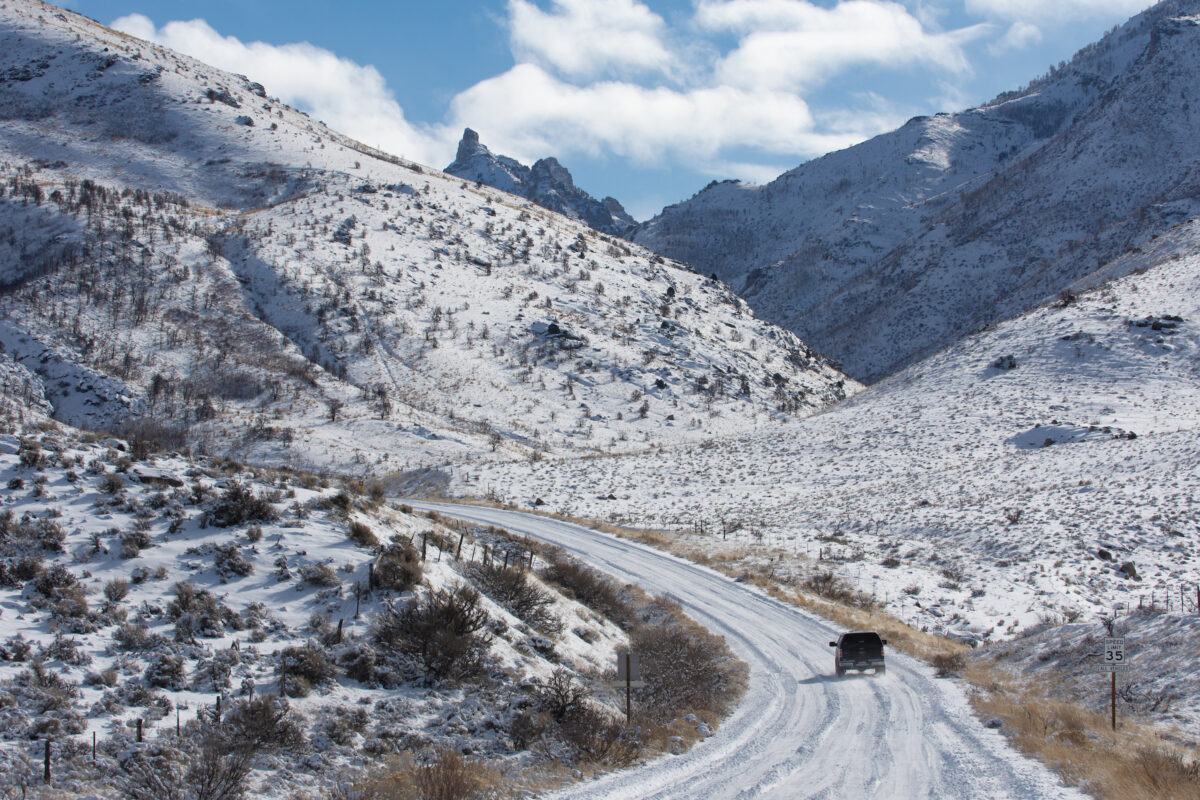Could Elko’s Ruby Mountains be home to Nevada’s next ski resort?

Nevada’s iconic Ruby Mountains could be home to Nevada’s next ski resort if the vision of a California businessman and Elko County ranch owner comes to fruition.
The range, known as the “Swiss Alps of Nevada” and revered for its rugged beauty, is a popular summer playground but is difficult to access in winter, with no formal ski infrastructure and access largely limited to helicopters and snowmobiles. While many want to see it remain wild, others want to see it developed into a reprieve from the crowds of legacy resorts in Tahoe, Utah and Colorado.
Earlier this year, Peter Christodoulo, a partner at a Bay Area technology investment firm, purchased a nearly 3,000-acre ranch in Elko’s Ruby Mountains that stretches from the valley floor to the crest of the range.
Now, Christodoulo is soliciting feedback from Elko County residents about the possibility of constructing a winter resort behind Spring Creek, a bedroom community between Elko and Lamoille Canyon. In addition to skiing, Christodoulo is interested in the area’s potential for mountain biking, hiking and a via ferrata — a mountain climbing sport that relies on fixed metal hardware to help people ascend a peak.
“Everybody that’s ever skied looks up there and says, ‘This is an opportunity,’” Mike Shanks, owner of Elko-based Modern Land and Development Construction LLC, said at an August Elko County Planning Commission meeting.
Shanks is working with Christodoulo to feel out the appetite of Elko-area residents and the planning commission for the project — rezoning approval from the commission is required to build a large-scale development.
“It’s got the vertical, it has the snow, it’s close to town and it’s private,” Shanks said. ““I’ve skied on the mountain — there’s definitely opportunity there.”
The proposal has taken on a life of its own, with online petitions in favor and against the project garnering hundreds of signatures from people not only around the Elko area, but from across the West.
Mitch Shanks, son of Mike Shanks, told the planning commission in August that “The area needs something like this,” while opponents cited concerns about wildlife, traffic and a change to the area’s rural character.
“I don’t want my hometown to become an expensive vacation spot,” one Lamoille resident wrote on the petition.
Speaking to The Nevada Independent about his idea, Christodoulo, who grew up skiing, said his goal is not to inflame area residents or “upset anybody.”
“I don’t have some grand plan here,” he said. “I love the mountains. I’ve always loved the mountains. I love skiing, I love hiking. I think you can put the Rubies in the same conversation as the Wasatch in Utah or the Sierra in California.
“It should be skied and it should be enjoyed by somebody.”
Elko boasts two other skiing and riding options. Ruby Mountain Heli, the oldest family-owned heli-skiing business in the United States, offers helicopter access to the Rubies, with packages costing several thousand dollars. The Elko SnoBowl, north of Interstate 80, is a small ski area featuring a community ski program and a single chairlift.
Multiple efforts have been made in the past to develop a resort, but none have come to fruition, leaving the Rubies largely inaccessible to most skiers.

Previous attempts to develop the Rubies
In a state known for its mountains, the Rubies are impressive, stretching for nearly 100 miles.
The range includes 10 peaks above 10,000 feet and more than two dozen alpine lakes. In an average year, the range receives about 300 inches of snow. (Palisades Tahoe receives about 400 inches per year; Park City, Utah receives just under 300 inches.)
It is home to one of the largest mule deer herds in the state, as well as mountain goats, bighorn sheep and Lahontan cutthroat trout, and is a popular summer backpacking and camping area.
In 1989, a portion of the range was federally protected when the more than 92,000-acre Ruby Mountains Wilderness was designated. The range has also been the focus of Nevada lawmakers who have introduced legislation to expand protections and prohibit oil and gas development in the range.
At the base of the Rubies are miles of rangeland, ranches and communities such as Spring Creek.
Earlier this year, Christodoulo closed on his purchase of Ruby Mountain Ranch. It had a listing price of $3.49 million and includes a lower, 900-acre parcel and an upper, 2,296-acre parcel.
The bottom parcel drops to an elevation of 5,600 feet; the upper acreage Christodoulo is considering developing spans from just over 6,000 feet to more than 9,400 feet with north-facing terrain and butts against Humboldt-Toiyabe National Forest land.
Christodoulo estimates about 1,200 to 1,500 acres of his property are suitable for skiing — about the size of Mount Rose Ski Tahoe, just west of Reno. He also estimates his property has roughly as much skiable, vertical drop as the Sierra’s iconic Palisades Tahoe.
“The whole thing skews expert and rugged … there’s a ton of cliffs, there’s a ton of very steep terrain,” he said.
Christodoulo remembers the days of uncrowded, big-name ski resorts such as Jackson Hole. Now, many major resorts are owned by multibillion-dollar companies that offer elite ski experiences but price out casual skiers.
If he were to build a resort, he’d go for something along the vibe of old-school Jackson Hole, Christodoulo said.
“All these resorts have been kind of destroyed by these enormous ski companies,” he said.
Christodoulo’s proposal is not the first for the Rubies, according to Teton Gravity Research, an extreme sports media company.
In 1955, the U.S. Forest Service issued a special use permit for a ski lodge and rope tow. Construction started on the project, but it was never completed.
In the 1970s, two more attempts were made at developing a resort.
In 1973, efforts were made to erect a lift and resort on Tent Mountain near Deeth. It was never built due to cost and land ownership issues.
Later that decade, plans were hatched to build a resort near Lamoille. City officials were so confident in the project that they purchased a Poma lift (a rudimentary lift that skiers hold onto instead of ride) but again, land issues and construction costs halted the project before it could get off the ground.
After the plans for the Elko resorts failed, Ruby Mountain Heli opened in 1977, offering guided backcountry ski tours of the Rubies. Using a helicopter instead of lifts for access opened the range to skiers while eliminating the need for other, costly factors associated with resorts such as hooking up to the power grid or artificially making snow in low-snow years.
Ruby Mountain Heli owner Joe Royer told the Elko Daily Free Press at the time his company opened that it would be hard to put in a ski resort in the Rubies.
“You would have to have a pocket that’s bottomless to do a good job,” he said.
Plans were also hatched to develop a small-scale community ski area north of town, across from the Rubies. The Elko SnoBowl opened in 1991 with two rope tows. In 1999, a single chairlift was added.
The efforts five decades ago to build a major resort in the Rubies came during a boom in ski resort development across the West.
In the 1970s, eight ski resorts were built across the country, including Montana’s Big Sky, Utah’s Powder Mountain and Snowbird and California’s Kirkwood and Northstar.
Two more resorts opened in the early 1980s — and then a dry spell of development ensued. As of May, no new destination ski area has opened in the United States since 1981.

Pros and cons
Online petitions for and against Christodoulo’s proposal have each garnered hundreds of signatures.
“Nothing like this exists in the area,” reads the petition, organized by Shanks, in favor of the development. It “could open an amazing opportunity for the community to enjoy year-round.”
Opponents disagree.
“No amount of positive economic impact could replace the lost resource,” says the petition against the project. “Land is one of the few things that we don’t get any more of. Once we develop this one, there won’t be another mountain to turn to.”
Christodoulo told The Nevada Independent he’s comfortable with whatever the planning commission decides.
If the commission does authorize a zoning change, he will seek capital partners and investors with the goal of “putting together some sort of ski resort.”
If the zoning change is not approved, “I’m totally at peace,” he said. “I will respect whatever the local community is supportive of.”
The property can still be skied, he said, by using a snowcat or installing a private lift for himself, family and friends.
“If I don’t get the rezoning, there’s no decision to make,” he said.
The Elko County Planning Commission will hold a public hearing on the matter on Nov. 21.
